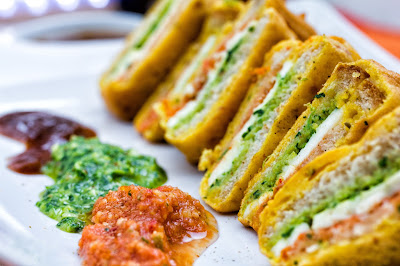 |
| Freshly fried samosas bursting with delicious pizza filling. |
I love my Mum's homemade crispy, delicate samosa pastry but these pizza samosas call for something with a bit more bite to make you feel like you're sinking your teeth into a deep dish pizza filled with saucy marinara and mozzarella. As a result the pastry I have put together is quite firm and requires a good amount of elbow grease to roll perfectly. Personally, I find the best way to do it is to portion the dough (16 pieces works for me but you can make your samosas bigger or smaller if you wish), roll into fairly smooth balls, flatten slightly with a rolling pin and then pass each ball of dough through a pasta roller up until it reaches grade 3. If you don't have a pasta roller or if you just prefer the good old fashioned rolling pin that's absolutely fine - it will only make these indulgent samosas even more worth it!
 |
| Reduce the sauce until thick but not completely dry. |
The filling outlined here is definitely Indian inspired - it's what works for my family and I but you can change it up to pretty much anything you like, just use the quantities as a guideline and be as creative as you like.
Ingredients:
For the dough:
300 g chapatti flour (use plain flour if you don't have chapatti flour)
1/2 tsp salt
40 g cold ghee/butter
10 tbsp cold water
1/2 tsp sunflower oil
For the filling:
2 medium red onions
1 tbsp sunflower oil
4 tsp crushed garlic
2 hot red chillies, finely chopped
1 tsp Italian mixed herbs
100 g mixed peppers, diced
1 x 400 g tin plum tomatoes
2 large tomatoes, diced
salt and black pepper to taste
125 g mozzarella torn into small pieces
Oil for frying
Method:
- Start by making the dough - weigh the flour into a large mixing bowl and sprinkle in the salt.
- Add the ghee/butter in small chunks and use the tips of your fingers to rub it into the flour until the mixture looks sandy.
- Make a well in the centre of the flour mixture and add about half of the cold water.
- Mix together adding more water 1 tablespoon at a time as required until the mixture comes together as a fairly smooth but firm dough.
- Knead the dough for 7 minutes, you will notice that it becomes smoother and slightly more elastic the longer you knead. When the 7 minutes are up the dough should come together a smooth dough.
- Drizzle the oil over the dough and rub it just lightly over the surface.
- Cover the dough with a slightly damp tea towel and leave aside to rest for at least one hour (ensure the tea towel isn't too wet otherwise the dough will absorb the liquid and become soggy).
- To make the filling start by roughly dicing the onions - we like a bit of bite so they don't need to be too fine but if you want a smoother sauce just go a bit smaller.
- heat up the oil in a wide, heavy based pan and when it becomes hot, add the onions.
- Stir fry the onions until they just begin to brown before adding the garlic, chillies, and herbs.
- Allow the spices to saute and release their flavours into the oil for a few moments before stirring in the peppers.
- Stir fry until the peppers are vibrant and crisp, then pour in the contents of the tin of tomatoes - don't liquidise this just add it as it is.
- Mix everything together well and add the diced tomatoes.
- As the sauce begins to heat through you will find that it is quite easy to roughly break up the plum tomatoes from the tin using the edge of your spoon, go ahead and break them up as much as you like.
- Season the sauce with salt and pepper and leave it to reduce until it becomes really nice and thick - remember if the sauce is too runny it will make filling and folding the samosas quite messy so you want the mixture to become really concentrated but not completely dried out either.
- When the sauce is the right consistency leave it aside to cool completely.
- To assemble the samosas, portion the dough and roll out the pastry until it is about 3 mm thick, I find grade 3 on a pasta roller is perfect. If you are using a pasta roller you will achieve long strips of pastry anyway but if you are rolling by hand - use two portions of dough at a time, combine into a ball and roll into a circle. Cut the circle in half and use each semi circle as one strip.
- Lay a strip of pastry horizontally in front of you and moisten along the bottom edge with a little water.
- Roll the pastry into an open cone using the moistened edge to stick the pastry together and create a point at the bottom of the cone.
- Turn the cone around so that the open mouth faces you.
- Add a little mozzarella to the cone first and then fill upwards layering sauce and mozzarella until the cone is three quarters full.
- Moisten the top edges of the pastry and fold them down to close the samosa - ensure the samosa is fully sealed so that it doesn't leak when frying.
- Once you have wrapped all of your samosas fry them in moderately hot oil to ensure the pastry is cooked through and the cheese inside is beautifully melted.
- If you wish you can sprinkle some salt, chilli powder and chaat masala onto the fried samosas whilst they are still hot to provide an extra burst of flavour and texture.
- Serve warm, preferably with a cup of masala chai :)







